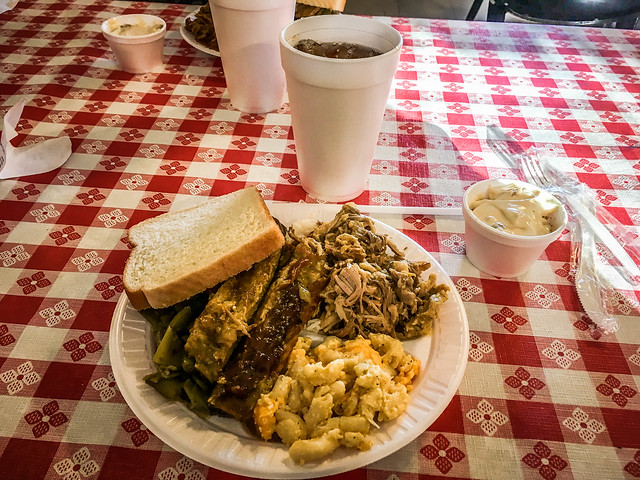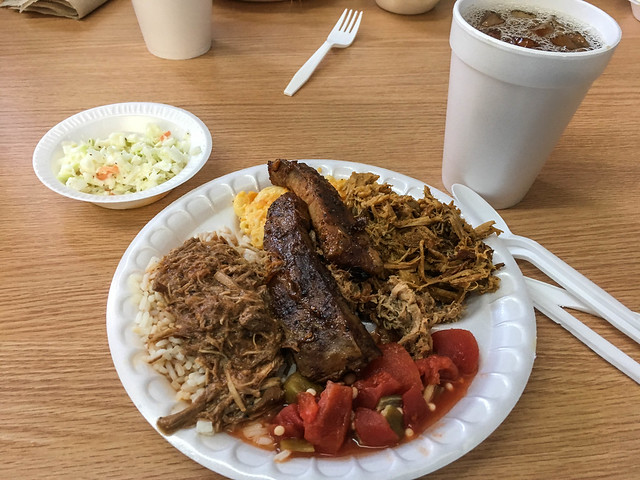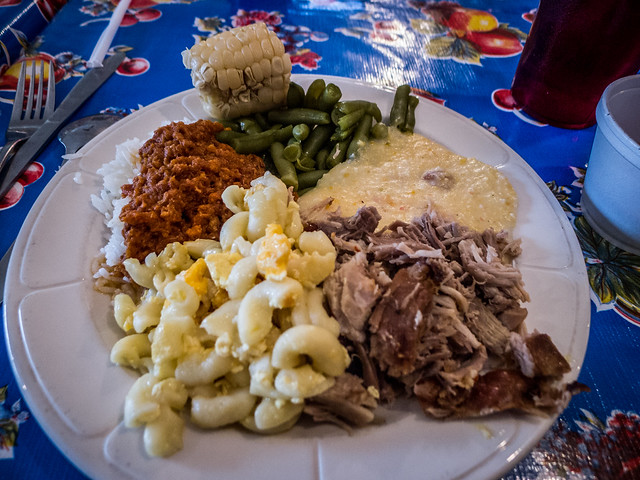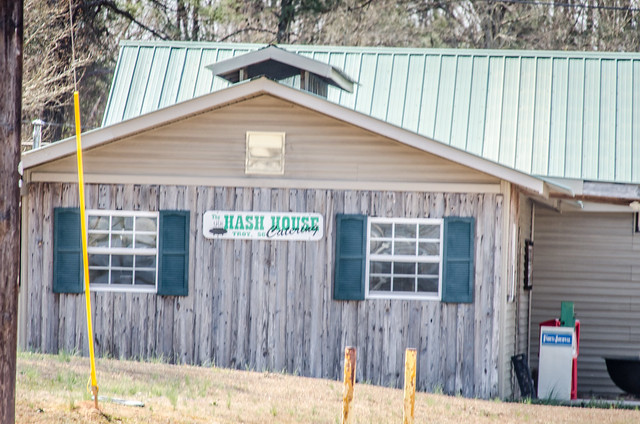
Some while back fellow paddler and geocacher Larry Easler posted a photo of a can label on Facebook. It was the label for Cambridge Hash. That garish orange, red, and blue label brought back a flood of memories. What I didn’t realize until Larry, who is from Ninety Six, posted this, is that “Cambridge” has nothing to do with the cities in either England or Massachusetts, but comes from the old name for Ninety Six, South Carolina. Spurred on my recent trip down that way, I decided I needed to find out more about this delicacy.
As a True Southerner™ I love hash. I’m not talking about that mostly potato abomination called corned beef hash.

(OK, full disclosure – I’ve never tasted corned beef hash. I actually like corned beef, so I’d probably really like it.)
photo from Simply Recipes
Neither am I talking about hash browns (which I do like, but as a True Southerner™ I’ll always opt for grits.) No, I’m talking about the grayish-brown snout-to-tail spicy concoction that consists mostly of stringy bits of nearly liquified pork.

Sometimes it’s referred to as “BBQ Hash” to differentiate it from all those other concoctions. And, as with BBQ, there is no shortage of opinions about which is the best hash and which regional variants are the tastiest. Like pulled-pork BBQ, there are mustard-based and tomato-based variations. There are differences in ingredients and the coarseness of the grind. What they have in common is that all of these variations were based on a way to use the whole hog and to stretch a resource so as to feed the maximum number of people as economically as possible.
With our large family, feeding a group of growing kids economically was a priority and hash buns were a regular feature of our diet. Most of the time it would be cans of Cambridge Hash purchased from the local Piggly Wiggly. On special occasions we would have hash from Wise’s Barbecue in Newberry. While on his way to the occasional meeting in Columbia Dad would stop by and get several quarts. Mom would put most of it in the freezer.

My last encounter with Cambridge Hash was as a freshman at Furman. I was living in an apartment off-campus and didn’t have a meal ticket, so I had to fend for myself as frugally as possible. I was in Winn-Dixie at University Square when I picked up a can of Cambridge. A sorority socialite-type coed with whom I shared a couple of classes happened by and scoffed at me for such a low-class choice of food. “How can you possibly eat that?!?” I bought it anyway and took it home for dinner, served up as always on a hamburger bun, washed down with a cheap Wiedemann beer because my parents weren’t around for further condemnation. ($3 a six-pack at Bo-Nats Convenience Store, back in the days when you could buy beer at age 18.)
That was my last encounter with Cambridge, not because I was ashamed, but because it simply slipped off my radar. Soon after that encounter I moved on campus and got a meal ticket. The next time Cambridge Hash crossed my mind it was long gone.
I still enjoy hash, but it’s usually served over rice rather than in a bun. Rather than go whole-hog, most places now use pork shoulder, the same cut they would use for pulled pork BBQ. My go-to supplier is Henry’s Smokehouse, who makes some of the best hash I’ve had. Before the pandemic hit I’d stop by for their hash and rice plate served with two sides, usually the green beens and sweet potato pie. These days I’ll pick up a pint occasionally to have either in a bun or over a baked potato with a dash of Tabasco to spice it up even more.



Sometimes I’ll try the hash and rice at BBQ buffets around the state, with varying degrees of satisfaction. I’m not a huge fan of the red variety, preferring spicy mustard, but it will do in a pinch. Here’s a sampling of my hash adventures around South Carolina, most taken pre-pandemic after various kayaking trips…
As for Cambridge Hash, it was a product of the Ninety Six Canning Company. The company also made Star Fort Meat Stew, which I never tried.


As mentioned earlier, Cambridge Hash was named for an ill-fated town in the old Abbeville district. In colonial days there was no town named Ninety Six, but there was the Ninety Six District. The British Star Fort was located here and figured prominently in the Revolutionary War. After the war a small town grew up around the fort, named “Cambridge” for a nearby academy. When the academy closed, the town died out, but was later reborn a couple of miles away as the town of Ninety Six.

Obviously, hash didn’t originate in Ninety Six. So what, exactly, is this stuff? From Websters we get the following:
noun: hash; plural noun: hashes
1. a dish of cooked meat cut into small pieces and cooked again, usually with potatoes. a finely chopped mixture.”
2. a hash of raw tomatoes, chili peppers, and cilantro, a mixture of jumbled incongruous things;
3. a mess.
Food historian Robert Moss traces the term back to England.
The stew’s name likely derives from “haslet,” an old English term for the viscera of a butchered animal. In nineteenth-century accounts, that stew was often referred to as “giblet hash” or “liver and lights hash”—“lights” being an old term for the lungs. In most early versions, the cook would start with a hog’s head, liver, and other organ meats and cook them with water in an iron stew pot over an open fire.
Robert F. Moss – The Story of Hash and Rice
This loose definition could fit many types of hash. The Canton Advocate from St. Louise spoke of hash this way in 1878…

Here’s the transcription of part of the article, which adds even more confusion to the mix…
The author of the above tender parody was probably one of those extremely enterprising men who do nothing themselves, but whose wives support them by keeping boarders. The lazy lubber composed this apostrophe to mixed food to still the grublings of over-hashed boarders.
What is hash? Ever one knows, yet none can define it. The ablest minds of this century have grappled with the problem and signally [sic] failed. Webster says it is a dish of minced and mixed meat, or met and vegtables [sic]; but this itself is only a cold, unseasoned hash of words, and no more expresses the popular idea of the viand in question than it does of mince pie…. Notwithstanding the general in definability of has, we may yet discuss its peculiarities and note its virtues and its vices. Hash is of two kinds: first, home-made hash; second, hotel or boarding house has. The first we learned to love and devour as children.
Very likely Mother made it; if not probably she superintended it…. Did we ever question the ingredients of the hash?…Oh no! There was mystery, but we had unlimited confidence in the legitimacy of the mystery. Then we grew to maturer years. Home was no more from hotel to restaurant and from restaurant to boarding house…How about the hash? It was there, it was everywhere, with a regularity wonderful to contemplate. But gradually suspicion took possession of the manly breast. He eyed the mystery frequently and sadly, and he eyed the waiter, the steward, and the landlady….
Somebody has said that it is safe to eat hash when the landlady eats hash, but the absence of the landlady in the hotel, restaurant, and most boarding houses, renders the rule useless. At rare intervals one finds a boarding house where everything is scrupulously near and elegant, so remindful of Mother and those youthful days, that he is justified in eating everything set before him. Such a place is a pearl of great price, and, when discovered, should be treasured up. Probably the best reccommendation [sic] that a private boarding house can have is that it is safe to eat its hash. It is useless to expect the Milleninum [sic] until the general practice of all the Christian graces and virtues has made has a universally safe article of diet — restored it to its pristine simplicity and popularity.
In his history of hash Robert Moss goes on to say that the Southern version of hash…
…originated sometime prior to the Civil War in the counties on either side of the Savannah River, which forms the border between Georgia and South Carolina. Estella Jones, who was born enslaved on Powers Pond Place near Augusta, recalled that when she was a child, some of the men would occasionally steal hogs from other plantations and “cook hash and rice and serve barbecue.”
The Abbeville Press and Banner published several accounts of hash being served at community barbecues in the 1850s, including the “rich hash” served at a barbecue at Matthews’ Spring in 1854 and the “tenderest, fattest mutton, nicely barbecued pig, smoking hash, Irish potatoes, beets, &c.” at a dinner at Robinson’s Spring in 1858. In 1861, at the opening of the Civil War, a barbecue was held to honor the Edgefield Riflemen, who hailed from the county just across the Savannah River from Augusta, as they prepared to leave for battle. The menu included “barbecued meats, and hash.”
Hash originated as a way to use up every bit of a pig when it was slaughtered, whether in preparation for a barbecue or at a more ordinary hog killing. A pig slaughtered for a barbecue would be butterflied and prepared to go on the pit. At hog killings in late fall, the pig’s fat would be rendered to lard and the hams, shoulders, and belly salted and hung in a smokehouse. In either case, the head, organs, and various other parts were left behind, and these ended up going into a large iron pot and rendered into hash.
Moss also states in his article that Big T’s in Gadsden is one of the only places left in South Carolina that “still make their hash with hogs heads and/or liver.” I kind of wish I’d known that before I got the hash and rice there after our last paddling trip.
Greenwood County’s long connection with hash started with a rather bizarre political incident. On May 22 of 1856, Congressman Preston Brooks from Edgefield attacked Massachusetts Senator Charles Sumner with a cane. Sumner had made a speech two days early against slavery in which he he also insulted pro-slavery South Carolina Senator Andrew Pickens Butler, a cousin of Brooks. Brooks entered the Senate chamber with several of his colleagues and proceeded to hit Sumner with his cane, causing serious injury.

Brooks resigned his House seat on July 6 and pleaded guilty in Washington to charges of assault and battery. He was convicted and fined $300, but on August 1 was re-elected right back into his old seat in a special election. On October 3rd of that year a special dinner was held in honor of Preston Brooks attended by nearly 10,000 people. The food served at that dinner was…wait for it…hash.
In 1959 a historical marker was erected to commemorate this dinner.

Brooks didn’t live long to bask in his victory, though. He died just a few months later in January of 1957 of “croup” at the age of 37. He was buried in Edgefield.
The style of hash served at this dinner became popular in Greenwood County. Bill McDaniel, Jr., son of a famous hashmaster for the mills in the county, recounted the origins of Ninety Six hash in an SCETV interview.
Sometime around 1929 William J. Connelly started the Connelly Canning Company in Ninety Six. At first his company only canned vegetables supplied by local farmers.

By 1936 Connelly renamed his company the Ninety Six Canning Company and expanded his offerings to include hash based on the local recipe.

Star Fort and Cambridge brands were advertised and sold throughout the region.


Cambridge Hash was a regular feature on local school menus.

But Ninety Six Canning wasn’t the only game in town. Local mills like Grendel Mill and Ninety Six Mill had hash houses that cooked inexpensive meals in large iron pots for their workers.
In the 1980s Greenwood County celebrated its hash history with an annual “Hash and History Festival”. These were centered around Star Fort near Ninety Six and focused more on the Revolutionary War history than on Preston Brooks brutal behavior. I don’t blame them.


As for Cambridge Hash, Bill Connelly sold the Ninety Six Canning Company to Larry Craig, a former NFL football player with the Green Bay Packers. When Craig passed away his cousin Jerry Gantt took over the business. The company was still producing hash as late as this article from 1995.

The SCETV series on hash interviewed Gantt about the business. One of the things I found interesting about his comments was the he talked about “stringy” meat as opposed to “chipped.” The stringy version is more akin to what you would find at Henry’s or Wise’s. Gannt said that they would refrigerate this for special occasions. The chipped hash would go into the cans. Basically, the Star Fort Meat Stew and Cambridge Meat Hash were the same thing, just labeled differently for some reason.
Sometime during the 1990s Ninety Six Canning Company ceased operations. All of the old hash houses have closed. The last was the Troy Hash House which closed in 2014.
While I was on my Ninety Six trek I tried to find some remnant of the old canning industry. I had a 1934 Sanborn Insurance Map of Ninety Six that showed a canning company on South Cambridge Street.

There was a modern bank branch at the location now. Beside that sat a building that looked sort of like the black and white photo of Ninety Six Canning from earlier in this post, but it’s not quite the same.

Surprisingly I didn’t see anything about Ninety Six hash at the Greenwood County Museum when I was there. I may have missed it.
It may have had its origins in slavery. It may be associated with a brutal assault in defense of that slavery. But I still love the flavor of hash. To me it’s comfort food. I like the stringy mustard-based hash, the spicier the better. I’ll eat it over rice, over a baked potato, or in a bun, regardless of what some sorority sister might say. Maybe someday I’ll even try corned beef hash. Who knows?











You made Cambridge hash for us early in my occupancy of Gray Court. I recall thinking it looked like dryer lint but tasted much, much better!
I had forgotten about that. That’s probably an apt description.
The photo you have is in fact the 96 cannery. I remember going there with my Dad to pickup a large batch for an event and Jerry Gantt (Brother of Wayne
Gantt of Blyth Funeral home) was there canning. His hash was much better prior to canning, this I remember well.
Just stumbled on this doing some research into “liver and lights” hash for a reader. Good stuff. Really nicely done.
Finally confirmed the family story I was told more than 50 years ago. The Connelly that started the ninety six canning company was my Great Great Grandfather’s son who moved from Prosperity, S.C. to Ninety Six along with his Mother and 2 brothers.
I was cutting grass today in August of 2023 thinking back to my childhood in Rock Hill, SC in the 1970s (before my mother remarried and we moved to NC) and I was thinking about the hash-in-a-can that my grandmother would heat up on the stove. She’d make some homemade biscuits and other things, perhaps fried okra or squash, some beans, etc. We’d cover the biscuits in that hash and it was the tastiest thing ever. I went off to college in 1986 to NC State and I remember getting my grandmother to mail me a few cans the summer before. I think that was probably the last time I had Cambridge Hash. Until just a few moments ago I didn’t even know or remember the brand name. I searched on newspapers.com in the Rock Hill Herald for Community Cash and hash. CC was the only place I ever saw her buy the stuff from. To be certain though, as good as I remember that Cambridge has being, nothing beats real hash. My grandfather was from Saluda County and I think down in that area of Edgefield, Saluda and Abbeville hash must be something special. He made it all the time when I was a kid in the same big black cast iron pot that we’d lower freshly slaughtered pigs into, filled with hot water to scrape the hair off. He was so militant about enjoying the hash that he’d literally get mad if someone brought over anything besides bread or rice since that’s the only two things he said went with hash and he didn’t want people filling up on unworthy foods like slaw or potato salad. I still eat it on bread when my dad makes it (which is less and less often now). I sure do miss pawpaw when I think about that. I’ve tried hash in other parts of SC but it’s just not the same the way my family makes it. I very rarely even see it outside of SC, maybe a few times in Georgia or Virginia. I travel a lot around the Southeast on business and look out for things like that!
Sooo nostalgic Greg. Sounds a lot like my Childhood in Carlisle SC. I still remember shopping with my grandmother at Community Cash in Union. Still remember that black cast iron pot, and yes, the same pot that was used for the hog slaughter. There was something about being there to witness it all. If you grew up in the country towns in the deep south, you know exactly what I mean. But yes, Cambridge was the best and will always be. Sounds like that was something we all grew up on. Too bad it’s obsolete these days. I would love for my son to be able to savor the flavor of Cambridge Hash just once in his lifetime.
I am from Aiken, SC and I purchased Cambridge hash from a Winn Dixie and a Food Lion here up until the late 1990’s. I also grew up eating it, as it was a popular quick meal for my mother to make when she began working at the Kimberly Clark plant in my early teens. My favorite hash recently is Caughman’s hash (chipped as you guys call it) from Lexington, SC sold in a few select locations in Aiken County. Daves Superette (a very old country store) in East Aiken County (HWY 302) sold it and I used to be able to find it at Shumperts in Williston SC. Dave passed away a couple of years ago and the new owners discontinued selling it and I can no longer find it at Shumpert’s and Lexington is a bit of a drive now. I have to settle for the hash at Carolina BBQ in New Ellenton, SC. It is very tasty still after all these years, but I do miss the Cambridge and as I know it is unhealthy to eat hash period, I still love it.
I was in search of some Cambridge hash for my son at my local Food Lion and couldn’t remember the name of it. Had a vivid picture of the orange and blue label in my head though. I grew up on Cambridge as a child in Carlisle SC, little town right outside of Union County SC. My grandfather originated from Greenwood SC, hence the introduction of Cambridge. This was a weekly staple on the dinner table and often breakfast table too. My granny would make a pot of grits on the wood burning stove with those homemade Hoe Cake biscuits and a nice pot of Cambridge Hash on the side. (My God Today..) in having a flashback!!!!! My how I miss those days. But in search of the hash in the grocery store, came up null and void. My mom reminded me of the history of Cambridge and how it’s practically obsolete these days. If anyone knows where to find this treasure, please come back and let us know. The closest thing I’ve had to it was probably Midway BarBQue in Union SC or when Mr. Benny Dawkins would make it in that big black cast iron wash pot and sell it to the locals in Carlisle. Might have to take a trip to Union pretty son.
I grew up in Lauren’s SC and am very familiar with Star Fort Hash and Cambridge Hash. We loved it!!,, My dilemma is I’ve lived in Chattanooga for over 40 years I can’t find either brand in any store. Can you tell me the closest store to me where it is sold. Do you offer online ordering and delivery. I would be thrilled to order in bulk quantities
Thanks for your reply
Mike, sadly, the company has long been out of business. Wish I had better news.
I wish this article was required reading for every team who decides to enter the hash competition at the Festival of Discovery (aka Blues and BBQfest) in Greenwood SC every July. The entries vary from some pretty good versions of Cambridge hash to Brunswick stew to some conglomerations that defy description. It does seem that SC hash is a regional thing and that the SC hash preference is sub-regionalized within SC. But the other poster’s grandfather was right – SC hash should only be accompanied by rice or white bread.
Thanks for a great article! I’m married to a southerner whose paternal side of the family is from Greenwood, and through him I was introduced to SC hash (being from the plains, the only hash Id known up to that point was the dog-food-appearance-abomination hash). He has talked about Start Fort hash, and his cousin makes huge batches for family reunions. This Kansas girl is a convert! I read him the article and he thoroughly enjoyed the history – his grandparents were mill workers.